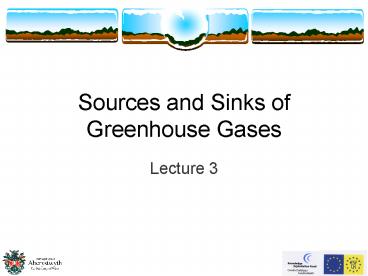Sources and Sinks of Greenhouse Gases PowerPoint PPT Presentation
1 / 35
Title: Sources and Sinks of Greenhouse Gases
1
Sources and Sinks of Greenhouse Gases
- Lecture 3
2
Introduction
- The greenhouse gases
- Sources
- Emissions
- Reducing emissions of CO2
- Carbon management
3
Greenhouse gases
4
Estimated anthropogenic contributions to global
warming
- Source IPCC 1997
5
The carbon reservoirs
- Atmosphere CO2
- Land living biota and organic matter
- Ocean dissolved CO2, small creatures
6
The carbon cycle
- .
7
Carbon dioxide (CO2)
- Atmospheric CO2
- 1890 280ppm
- 2000 360ppm
- 2050 600ppm
Time trend in atmospheric CO2 concentration at
Mauna Loa Observatory, Hawaii (Keeling et al.,
1995).
8
Carbon dioxide (CO2)
- Rising by 1.5 ppm per year
- Average atmospheric lifetime 50 - 200 years
- Growth rate 0.45
- Anthropogenic sources
- Fossil fuel combustion (75)
- Deforestation (24)
- Cement production (1)
9
CO2 emissions influenced by
- Size of human population
- Amount of energy used per person
- Level of emissions resulting from that use of
energy
10
CO2 emissions can be reduced by
- Improving energy efficiency
- Fuel switching
- Use of renewable energy
- Nuclear power
- Capture and storage of CO2
11
Methane (CH4)
- Atmospheric concentration
- 1860 750 ppb
- 2000 1750 ppb
- Average atmospheric lifetime
- 12 years
- Growth rate 0.6
12
Methane (CH4)
- Natural sources
- anaerobic decomposition of organic substances in
biological systems - wood digestion by termites
- oceans, seas and lakes
13
Methane (CH4)
- Anthropogenic sources
- Fossil fuel extraction (20)
- Dams, reservoirs (20)
- Livestock digestion (18)
- Rice paddies (17)
- Landfill sites (10)
- Animal manure/slurry (7)
14
UK methane emissions
Source National Atmospheric Emissions Inventory
15
Nitrous oxide (N2O)
- Atmospheric concentration
- 1860 285ppb
- 2000 312 ppb
- Average atmospheric lifetime 120 years
- Growth rate 0.25
16
Nitrous oxide (N2O)
- Natural sources
- Oceans
- Soils
- Forests
- Meadows
17
Nitrous oxide (N2O)
- Anthropogenic sources
- Poor soil management (70)
- Transport (14)
- Industrial processes (7)
18
UK N2O emissions
Source National Atmospheric Emissions Inventory
19
Halogenated compounds
- Contain
- Fluorine
- Chlorine
- Bromine
- Iodine
- All are greenhouse gases
- Halogens with carbon and chlorine or bromine
cause ozone depletion - CFCs
- Halons
- HCFCs
20
Chlorofluorocarbons (CFCs)
- Example CFC 12
- Atmospheric concentration
- 1860 0
- 2000 533 ppt
- Average atmospheric lifetime 102 years
- Growth rate 1
21
Chlorofluorocarbons (CFCs)
- Anthropogenic sources
- aerosol propellants
- blowing agents for plastic foams
- refrigerants
- solvents
22
CFC replacements
- Hydrofluorocarbons (HFCs)
- Perfluorocarbons (PFCs)
- Sulphur hexafluoride (SF6)
23
HFCs, PFCs and SF6
- Industrial processes
- Levels increasing
- Very long lifetime
24
Reducing CO2 emissions
- UK government aim
- UK to a low carbon economy
- EU emissions trading scheme
- Start 2005
- Mandatory for some companies
- Penalties if goals not met
25
Carbon management
- The Carbon Trust
- 5 steps
26
Step 1. Evaluate business case
- Develop an overall understanding of climate
change and its risks and opportunities for your
company
27
Step 2. Develop strategic objectives
- Develop and agree overall objectives and approach
to carbon management
28
Step 3. Identify opportunities
- Establish a detailed picture of company-wide
emission assets and liabilities - Generate and evaluate specific ideas for
achieving cost effective emission reductions
29
Step 4. Develop an implementation plan
- Prioritise ideas, reflecting overall corporate
objectives and aspirations - Develop an overall implementation plan including
specific emission reduction targets
30
Step 5. Manage implementation
- Monitor the progress of the plan and its
effectiveness in delivering the specified
objectives - Review progress and update plan accordingly
31
How to reduce emissions
- Buy green energy
- http//www.greenelectricity.org/
- Best supplier of green energy
- http//www.greenprices.com/uk/pricesbox.asp
32
Driving tips to reduce energy
- Avoid hard acceleration
- Keep your speed down
- Only make essential car journeys
- Walk or cycle on short trips
- Share car journeys with others
- Service the car regularly
- Check your tyre pressure every week
- Travel outside the rush hour to avoid congestion
- Travel light and remove unnecessary loads and
roof racks
33
Save energy to reduce emissions
- Electricity use
- Fuel use
34
British Sugar
- 40 reduction in energy
- 40 reduction in water usage
35
References
- www.vegansociety.com/html/whyvegan/whyenvt.html
- www.futureforests.com/explainmore/reduceyouremissi
ons.asp - www.earthfuture.com/stormyweather/greenhouse/
- www.met-office.gov.uk/research/hadleycentre/models
/carbon_ - cycle/intro_global.html
- http//www.aeat.com/netcen/airqual/naei/annreport/
annrep98/na ei98.html - http//www.climate.org.ua/ghg/ghg_.html
- http//www.britishsugar.co.uk
- Petit et al., 1999
- Keeling et al., 1995
- IPPC-Working Group 1, 2001

